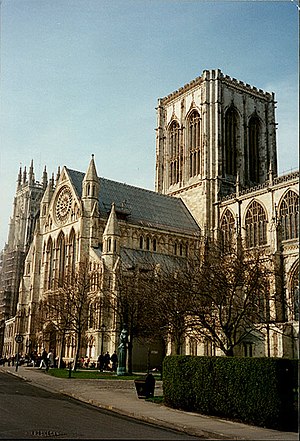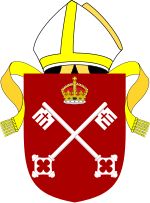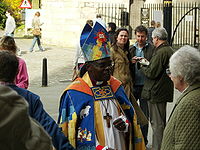Province of York
The Province of York is one of two provinces making up the Church of England, the other being the Province of Canterbury. The Province of York consists of 14 dioceses which cover the northern third of England and also the Isle of Man.[1]
The Archbishop of York acts also as the diocesan bishop of the Diocese of York. His seat is York Minster, formally known as The Cathedral and Metropolitical Church of St Peter in York.
The province was created in 735 when Ecgbert Bishop of York was raised to the status of Archbishop. At one time, the Archbishops of York also claimed metropolitan authority over Scotland but these claims were disputed by the Scottish bishops in the Middle Ages and the claim ceased when the office of Archbishop of St Andrews was established to oversee the bishops of Scotland.
Contents
Dioceses
The twelve dioceses overseen by the Province are:
History
Roman
There was a bishop in York from very early Christian times. Bishops of York were present at the Councils of Arles and Nicaea. However, this early Christian community was later destroyed by the pagan English and there is no direct succession from these bishops to the post-Augustinian ones.
Early Middle Ages
The diocese is said to have been refounded by Paulinus, a member of Augustine's mission, in the 7th century. Notable among these early bishops is Wilfrid. These early bishops of York acted as diocesan bishops under Canterbury until the time of Ecgbert of York, who was elevated to become an Archbishop in 735 and established metropolitan rights in the north. Until the Danish invasion the archbishops of Canterbury occasionally exercised authority, and it was not till the Norman Conquest that the archbishops of York asserted their complete independence.
In the later Anglo-Saxon period it became usual for the See of York to be held in plurality with the Worcester, and sometimes Lichfield, and Lincoln, since the Norsemen had mae such depredations upon the estates formerly held by the Archbishops in earlier ages that they did not have sufficient income to maintain the Archbishop and his court in a proper state,
The dioceses in the Northern Isles and in Scotland were taken from York in 1072. In 1154 the suffragan sees of the Isle of Man and Orkney were transferred to the Norwegian archbishop of Nidaros (today's Trondheim), and in 1188 all the Scottish dioceses except Whithorn were released from subjection to York, so that only the dioceses of Whithorn, Durham and Carlisle remained to the Province. Of these, Durham was practically independent, for the palatine bishops of that see were little short of sovereigns in their own jurisdiction.
Several of the archbishops of York held the ministerial office of Lord Chancellor of England and played some parts in affairs of state. As Peter Heylyn (1600–1662) wrote: "This see has yielded to the Church eight saints, to the Church of Rome three cardinals, to the realm of England twelve Lord Chancellors and two Lord Treasurers, and to the north of England two Lord Presidents." The bishopric's role was also complicated by continued conflict over primacy with the see of Canterbury.
Reformation
At the time of the English Reformation, York possessed three suffragan sees, Durham, Carlisle and Sodor and Man and the new Diocese of Chester, founded by Henry VIII. At this time many of the secular rights belonging to the Archbishop were removed, though the Bishop of Durham's remarkable palatine jurisdiction remained for centuries.
Walter de Grey purchased York Place in London, which after the fall of Cardinal Thomas Wolsey, was renamed the Palace of Whitehall.
Industrial Revolution and after
The Industrial Revolution vastly increased the populations of the towns in County Durham, Lancashire and Yorkshire and the industrial centres on the Tyne in Durham and Northumberland. As a result several new dioceses were created to give today's total of fourteen.
In 2012 the Dioceses Commission decided that the number of dioceses in Yorkshire should be reduced, which decision is still (2013) being considered.
Archbishop of York
The province's metropolitan bishop is the Archbishop of York, who also bears the title “Primate of England” (while his southern colleage in Caterbury is the “Primate of All England”, a formula derived from a mediæval compromise). York is the second of the Church’s archbishops, though amongst the bishops of the church they are considered “first amongst equals”.
The archbishop's throne is in York Minster in the heart of the City of York. His official residence is Bishopthorpe Palace in the village of Bishopthorpe, outside the city.
The Archbishop signs as Ebor., from the Latin name of York; Eboracum. (The current archbishop, John Sentamu signs not as "+John Ebor" but as as +Sentamu Ebor: since both "John" and "Sentamu" are Christian names.)
Anglo-Saxon Period
| Bishops of York | |||
|---|---|---|---|
| From | Until | Incumbent | Notes |
| 626 | 633 | Paulinus | Formerly a monk at St. Andrew's Monastery in Rome; translated to Rochester; canonised.[2] |
| 633 | 664 | Vacant | |
| 664 | 669 | Chad of Mercia | Resigned the York; later became Bishop of Mercia and Lindsey; canonised. |
| 664 | 678 | Wilfrid (I) | Ejected from York; later became Bishop of Selsey; canonised. |
| 678 | 706 | Bosa | Canonised. |
| 706 | 714 | John of Beverley | Translated from Hexham; resigned the see; canonised in 1037. |
| 714 | 732 | Wilfrid (II) | Resigned the see; canonised. |
| c. 732 | 735 | Ecgbert | York elevated to Archbishopric in 735. |
| Archbishops of York | |||
| From | Until | Incumbent | Notes |
| 735 | 766 | Ecgbert | York elevated to Archbishopric in 735. |
| c. 767 | c. 780 | Æthelbert | Also known as Æthelbeorht, Adalberht, Ælberht, Aelberht, Aldbert or Æthelbert. |
| c. 780 | 796 | Eanbald (I) | |
| 796 | c. 808 | Eanbald (fl. 798) (II) | |
| c. 808 | c. 834 | Wulfsige | |
| 837 | 854 | Wigmund | |
| 854 | c. 896 | Wulfhere | Fled the Danes in 872, returned in 873. |
| 900 | c. 916 | Æthelbald | Sometimes known as Æthelbeald, Athelbald, or Ethelbald. |
| c. 916 | 931 | Hrotheweard | Sometimes known as Lodeward. |
| 931 | 956 | Wulfstan (I) | |
| c. 958 | 971 | Oscytel | Translated from Dorchester; also known as Oscytel. |
| 971 | Edwald | Also known as Edwaldus or Ethelwold. | |
| 971 | 992 | Oswald of Worcester | Held both the sees of York and Worcester; canonised. |
| 995 | 1000 | Ealdwulf | Held both the sees of York and Worcester. |
| 1002 | 1023 | Wulfstan (II) | Held both the sees of York and Worcester until 1016. |
| 1023 | 1041 | Ælfric Puttoc | Held the sees of York and Worcester 1040–41; ejected from both in 1041. |
| 1041 | 1042 | Æthelric | Elected Archbishop in 1041, but was quashed in 1042. |
| 1042 | 1051 | Ælfric Puttoc (again) | Restored to York only. |
| 1051 | 1060 | Cynesige | Also known as Kynsige. |
| 1061 | 1069 | Ealdred | Held the see of Worcester 1046-61, of Hereford 1056-60, and of York 1061-69; also known as Aldred. |
| Source(s): Crockfords | |||
Conquest to Reformation
| Archbishops of York (Conquest to Reformation) | |||
|---|---|---|---|
| From | Until | Incumbent | Notes |
| 1070 | 1100 | Thomas of Bayeux | Also known as Thomas (I). |
| 1100 | 1108 | Gerard | Hereford. |
| 1109 | 1114 | Thomas (II) | |
| 1119 | 1140 | Thurstan | He was elected in 1114, but wasn't consecrated until 1119. |
| 1140 | Waltheof of Melrose | Nominated Archbishop, but was quashed by King Stephen; later became Abbot of Melrose. | |
| 1140 | Henry de Sully | Abbot of Fécamp Abbey. Nominated Archbishop, but was quashed by Pope Innocent II. | |
| 1143 | 1147 | William (FitzHerbert) | Deposed by Pope Eugene III; canonised in 1226. |
| 1147 | 1147 | Hilary of Chichester | Chichester. |
| 1147 | 1153 | Henry Murdac | Formerly Abbot of Fountains Abbey. |
| 1153 | 1154 | William (FitzHerbert) (again) | Restored by Pope Anastasius IV; canonised in 1226. |
| 1154 | 1181 | Roger de Pont L'Évêque | Formerly Archdeacon of Canterbury. |
| 1191 | 1212 | Geoffrey (Plantagenet) | Formerly Bishop-elect of Lincoln; elected Archbishop in 1189, but only consecrated in 1191. |
| 1215 | Simon Langton | Elected Archbishop of York in June 1215, but was quashed on 20 August 1215 by Pope Innocent III on request from King John; later Archdeacon of Canterbury. | |
| 1216 | 1255 | Walter de Gray | Translated from Worcester. |
| 1256 | 1258 | Sewal de Bovil | Formerly Dean of York. |
| 1258 | 1265 | Godfrey Ludham | Formerly Dean of York; also known as Godfrey Kineton. |
| 1265 | William Langton | Dean of York (1262–1279); elected Archbishop in March 1265, but was quashed in November 1265.[3] | |
| 1265 | 1266 | Bonaventure | Selected as Archbishop in November 1265, but never consecrated and resigned the appointment in October 1266. |
| 1266 | 1279 | Walter Giffard | Translated from Bath and Wells. |
| 1279 | 1285 | William de Wickwane | |
| 1286 | 1296 | John le Romeyn | Also known as John Romanus. |
| 1298 | 1299 | Henry of Newark | Formerly Dean of York. |
| 1300 | 1304 | Thomas of Corbridge | |
| 1306 | 1315 | William Greenfield | Formerly Dean of Chichester |
| 1317 | 1340 | William Melton | |
| 1342 | 1352 | William Zouche | Also known as William de la Zouche. |
| 1353 | 1373 | Cardinal John of Thoresby | Translated from Worcester; created a cardinal in 1361. |
| 1374 | 1388 | Alexander Neville | St Andrew's in 1388. |
| 1388 | 1396 | Thomas Arundel | Translated from Ely; translated to Canterbury. |
| 1397 | 1398 | Robert Waldby | Chichester. |
| 1398 | 1398 | Walter Skirlaw | Bishop of Durham, elected but put aside by King Richard II. |
| 1398 | 1405 | Richard le Scrope | Translated from Lichfield. |
| 1405 | 1406 | Thomas Langley | Elected Archbishop in August 1405, but was quashed in May 1406. |
| 1406 | 1407 | Robert Hallam | Nominated Archbishop in May 1406 by Pope Innocent VII, but vetoed by King Henry IV. |
| 1407 | 1423 | Henry Bowet | Translated from Bath and Wells. |
| 1423 | 1424 | Philip Morgan | Elected Archbishop in 1423, but was quashed in 1424. |
| 1424 | 1425 | Richard Fleming | Conferred as Archbishop by Pope Martin V, but was refused by King Henry V, and Fleming resigned the appointment in July 1425. |
| 1426 | 1452 | Cardinal John Kemp | Translated from London; created a cardinal in 1439; translated to Canterbury. |
| 1452 | 1464 | William Booth | Translated from Lichfield. |
| 1465 | 1476 | George Neville | Translated from Exeter. |
| 1476 | 1480 | Lawrence Booth | Translated from Durham. |
| 1480 | 1500 | Thomas Rotherham | Translated from Lincoln. |
| 1501 | 1507 | Thomas Savage | Translated from London. |
| 1508 | 1514 | Cardinal Christopher Bainbridge | Translated from Durham; created a cardinal in 1511. |
| 1514 | 1530 | Cardinal Thomas Wolsey | Translated from Lincoln in 1514; created a Cardinal in 1515; held with Bath and Wells 1518-23, Durham 1523-29 and Winchester 1529-30. |
| Source(s): Crockfords | |||
Archbishops from the Reformation
| Post-Reformation Archbishops of York | |||
|---|---|---|---|
| From | Until | Incumbent | Notes |
| 1531 | 1544 | Edward Lee | Translated from St David's. |
| 1545 | 1554 | Robert Holgate | Translated from Llandaff. |
| 1555 | 1559 | Nicholas Heath | Translated from Worcester. |
| 1561 | 1568 | Thomas Young | Translated from St David's. |
| 1570 | 1576 | Edmund Grindal | Translated from London; translated to Canterbury. |
| 1577 | 1588 | Edwin Sandys | Translated from London. |
| 1589 | 1594 | John Piers | Translated from Salisbury. |
| 1595 | 1606 | Matthew Hutton | Translated from Durham. |
| 1606 | 1628 | Tobias Matthew | Translated from Durham. |
| 1628 | George Montaigne | Translated from Durham. | |
| 1629 | 1631 | Samuel Harsnett | Translated from Norwich. |
| 1632 | 1640 | Richard Neile | Translated from Winchester. |
| 1641 | 1650 | John Williams | Translated from Lincoln. |
| 1650 | 1660 | Vacant | |
| 1660 | 1664 | Accepted Frewen | Translated from Lichfield. |
| 1664 | 1683 | Richard Sterne | Translated from Carlisle. |
| 1683 | 1686 | John Dolben | Translated from Rochester. |
| 1688 | 1691 | Thomas Lamplugh | Translated from Exeter. |
| 1691 | 1714 | John Sharp | Formerly Dean of Canterbury. |
| 1714 | 1724 | Sir William Dawes Bt | Translated from Chester. |
| 1724 | 1743 | Lancelot Blackburne | Translated from Exeter. |
| 1743 | 1747 | Thomas Herring | Translated from Bangor; translated to Canterbury. |
| 1747 | 1757 | Matthew Hutton | Translated from Bangor; translated to Canterbury. |
| 1757 | 1761 | John Gilbert | Translated from Salisbury. |
| 1761 | 1776 | The Hon Robert Hay Drummond | Translated from Salisbury. |
| 1776 | 1807 | William Markham | Translated from Chester. |
| 1808 | 1847 | The Hon Edward Venables-Vernon from 1831: The Hon Edward Venables-Vernon-Harcourt |
Translated from Carlisle. |
| 1847 | 1860 | Thomas Musgrave | Translated from Hereford. |
| 1860 | 1862 | Charles Longley | Translated from Durham; translated to Canterbury. |
| 1862 | 1890 | William Thomson | Translated from Gloucester. |
| 1891 | William Magee | Translated from Peterborough. | |
| 1891 | 1908 | William Maclagan | Translated from Lichfield. |
| 1909 | 1928 | Cosmo Gordon Lang | Former Suffragan Bishop of Stepney; translated to Canterbury. |
| 1929 | 1942 | William Temple | Translated from Manchester; translated to Canterbury. |
| 1942 | 1955 | Cyril Garbett | Translated from Winchester. |
| 1956 | 1961 | Michael Ramsey | Translated from Durham; translated to Canterbury. |
| 1961 | 1974 | Donald Coggan | Translated from Bradford; translated to Canterbury. |
| 1975 | 1983 | Stuart Blanch | Translated from Liverpool. |
| 1983 | 1995 | John Habgood | Translated from Durham. |
| 1995 | 2005 | David Hope | Translated from London. |
| 2005 | present | John Sentamu[4] | Translated from Birmingham. |
| Source(s): Crockfords | |||
Suffragan
The Bishop of Beverley is the Provincial Episcopal Visitor in the Province, popularly known as a "flying bishop". It is his role to minister to parishes which reject the ordination of wonen as priests.
See also
Outside links
References
- ↑ Cannon, John (2002). "York, metropolitan diocese of". The Oxford Companion to British History. Oxford University Press. http://www.encyclopedia.com/doc/1O110-Yorkmetropolitandioceseof.html. Retrieved 2009-08-08.
- ↑ St. Paulinus, Archbishop of York. Retrieved on 20 November 2008.
- ↑ William de Langeton alias of Rotherfield
- ↑ The Archbishop of York
Books
Story, Joanna (August 2012). "Bede, Willibrord and the Letters of Pope Honorius I on the Genesis of the Archbishopric of York". English Historical Review cxxvii (527): 783-818.
| Dioceses of the Church of England |
|---|
|
Province of Canterbury: |


